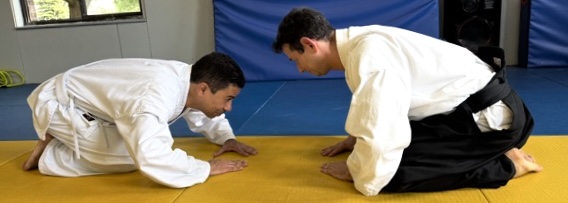
It sometimes seems like people are expected to learn Rei (traditional etiquette) by osmosis. I’d like to explain it a bit.
One of the paradoxes of budo is remaining polite and friendly with your training partners despite executing techniques on them that can be painful.
Rei is one key to maintaining this smooth relationship.
The harmony of the dojo is structured on routinely showing respect and bowing – to the art (as symbolised by O-sensei), the dojo community, the instructor and your training partners.
This kind of respect has nothing to do with personal feelings. Personal respect is something we have little control over. In your heart, you either truly respect someone or you don’t.
That doesn’t matter.
Show proper etiquette even to people you may not truly respect in that personal sense — not as a reflection on their character, but as a reflection of yours. Most of us are struggling in our own ways to learn this art and improve ourselves.
An instructor’s mutual bow with a beginner is a sign that both acknowledge dojo tradition and respect each other’s roles.
A standing bow should be returned with a standing bow, a seated bow with a seated bow. “Hanmi handachi” bowing should generally be avoided.
When bowing to a partner, get close enough to him or her that you can easily hear them speak while maintaining ma’ai. Don’t bow from across the room. Wait to bow until there is no obstruction (such as another student) between you and the partner. Pay attention to the person you’re bowing to. Careless bowing is rude.
Bowing in our dojo has no religious connotations. If you are strictly forbidden to bow in any context except for religious services by your spiritual leaders, ask the dojocho for advice.
Bowing in our dojo has no connotations of subservience or inequality. However, it is normal for a significantly lower ranked student to bow a little sooner and deeper to a significantly higher ranked one.
When to bow:
- Seated, when first stepping on to the tatami, to the Shomen (front of the dojo/portrait of the Founder) as a show of respect to the art and the community
- Seated in a line, to the Shomen when class starts
- Seated, in a line, to the instructor as he or she greets you when starting the class
- Seated, whenever the instructor demonstrates a technique
- Seated, to your partner as you agree to practice
- Seated or standing when you complete practice with your partner
- Seated as a group, to the Shomen (front of the dojo/portrait of the Founder) at the end of class
- Seated, as a group, to the instructor as he or she personally ends the class
- Seated or standing after the class is over to all your partners
- Seated, when leaving the tatami
(It is seldom wrong to bow if it seems appropriate. Seated bows are considered more polite than standing ones.)